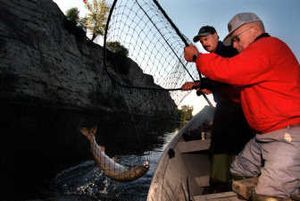Yakima River spring chinook fishing opens Wednesday
SALMON FISHING -- Two sections of the Yakima River will open this week to fishing for hatchery-reared spring chinook salmon, under regulations announced late this afternoon by the Washington Department of Fish and Wildlife.
Wednesday, May 16, the lower Yakima River will open to fishing for hatchery spring chinook from the Interstate 182 Bridge in Richland to the Grant Avenue Bridge in Prosser.
Saturday, May 19, the salmon fishery will expand to the upper Yakima River from the Interstate 82 Bridge at Union Gap to the railroad bridge below Roza Dam.
John Easterbrooks, regional WDFW fish program manager, said the lower river is expected to remain open through June 30, while fishing in the upper section will likely continue through July 31.
“The springers are running late this year, but they’re finally moving into the Yakima River,” said Easterbrooks, noting that fishery managers are predicting a return of approximately 5,000 adult hatchery chinook to the Yakima River.
Read on for details.
Anglers will have a daily limit of two adipose-fin-clipped hatchery chinook. All wild salmon, identifiable by an intact adipose fin, must be released unharmed and must not be removed from the water prior to release. The same is true for all steelhead, as noted in the fishing rule on WDFW’s website (https://fortress.wa.gov/dfw/erules/efishrules/).
To participate in the fishery, anglers must possess a Columbia River Salmon/Steelhead Endorsement (CRSSE), along with a valid fishing license. Anglers also have the option of purchasing a “two-pole endorsement” to fish with two poles during the fishery.
Revenues from the CRSSE will be used to fund monitoring and law enforcement for the fishery, and to expand the lower river fishery up to Prosser this year.
Endorsement revenues will also fund a hooking-mortality study for spring chinook salmon this year below Roza Dam, where a WDFW research team plans to radio-tag 150 wild fish that have been hooked, played and released.
“Anglers who have hooked a spring chinook may be approached by a scientific technician as they reel in the fish,” Easterbrooks said. “If it’s a wild fish with an intact adipose fin, the technician will offer to assist in unhooking and releasing it after tagging it and recording information on the fish.”
The technicians will also be fishing to catch fish for the study, and will release all fish they catch once they have been tagged. At the end of the spawning season, survival rates for all spring chinook that have been tagged and released will be compared against a control group of fish that have not been hooked by anglers.
“This study, conducted in conjunction with the Yakama Nation, will not only be useful in estimating hooking mortality rates on the Yakima River but also on other tributaries to the Columbia River,” he said. “We would appreciate anglers’ cooperation as we work to refine estimates that play a key role in managing area fisheries.”
Easterbrooks is also asking for anglers’ cooperation in helping to maintain access across Roza Dam to the popular fishing area downstream from the railroad bridge boundary. He asks that anglers observe some basic rules established by U.S. Bureau of Reclamation, which owns the facility:
- Passage across the dam is limited to walk-in access to the right (west) bank of the river. The public is prohibited from using the railroad bridge walkway to access the left (east) bank-fishing area. Anglers can access both sides of the river by walking under the bridge abutments to access the fishing area downstream.
- Anglers are asked to park in the designated areas on the right side of the Roza Access Road, not on private property on the left side of the road.
- Dumpsters have been placed at the parking area and next to the Roza adult fish trapping facility. Anglers are asked to carry a trash bag and deposit their trash – along with any they find along the trail – in those dumpsters.
- Anglers are also asked to use the portable toilets provided at the access road parking area and on the west side of the dam.
“Public access across Roza Dam is a privilege, not a right,” Easterbrooks said. “We’re asking anglers to do everything they can to make sure that access point remains open for their use.”

